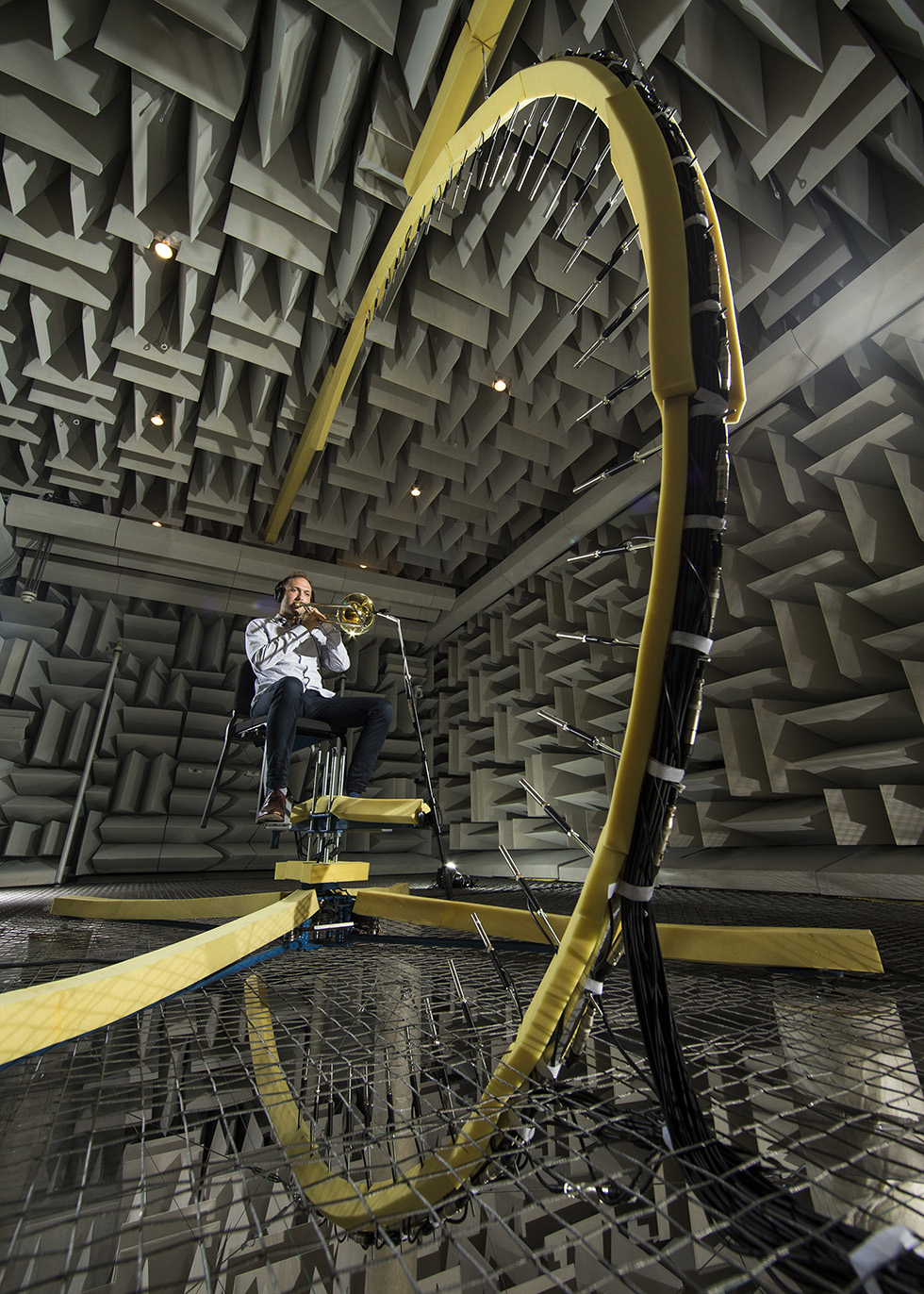
Copyright BYU Photo 2014 All Rights Reserved
Joshua Bodon is sick of hearing “Somewhere Over the Rainbow.” More specifically, he’s sick of hearing one 25-second clip of the song repeated more than 550 times.
For almost two years, this physics grad student has been testing how sound radiates from live musical instruments, which includes hearing the same song over and over…and over. But the monotony has a purpose; it’s all about helping musicians, instrument makers, concert hall designers, audio engineers and music producers enhance sound quality.
The work takes place in one of two anechoic chambers at BYU. Anechoic, meaning “free from echoes and reverberation,” describes a room built with walls that absorb sound energy, so noise can’t bounce back to a listener.
Bodon and physics professor Timothy Leishman devised a recording system with a rotating chair and a semicircular array of 37 microphones that puts musicians out of their comfort zone.
“Some people go in there and it’s so quiet that it feels like everything is imploding in on them,” said Darin Bradford, a music professor who played several instruments for the research. “I was really happy to be involved – it was a really fascinating experience.”
The musicians who play for the study face three difficulties that they never encounter in a concert hall:
- They have to sit on a chair elevated several feet above the floor. That allows the research team to capture sound that radiates downward.
- The walls don’t bounce sound back to the musician, which changes how they hear the notes they play. If any note in a chromatic scale or musical excerpt is slightly off-key, they’ve got to start over.
- While they play, they have to keep a laser that’s attached to their instrument pointed inside of a target. Slight movements that move the laser outside of the target alter the direction of the sound waves.
When they finally get everything right, the chair rotates five degrees, and they do it all over again. The process repeats 72 times until the 360-degree revolution has been completed. A complete recording for one instrument can take anywhere from five to eight hours. Fortunately these musicians – both students and faculty at BYU – get paid. They also get a break each time they have rotated 90 degrees.
When the recordings are finished, Bodon and his team of three undergraduates, Michael Dennison, Claire McKellar and Michael Rose sort through the data – about 250 gigabytes per instrument. The students create balloon plots that map each instrument’s sound radiation over a sphere. The team has become so proficient at this process, that they can do it start to finish in less than 24 hours.
So far the team has completed recordings and mapping of the cello, violin, trombone, French horn, baritone saxophone, oboe, clarinet, bassoon, viola and trumpet.
The recording system provides better “directivity mapping” for instruments than what is currently available in the music industry. It uses the 37-microphone array to record at each five-degree musician rotation, resulting in 2,522 data points that show visually how the sound radiates from the instrument. Here is an animation of the sound radiating from a bassoon:
The tedious work is rewarding for the students both in study’s findings and in research experience. Early in their college experience, they’re learning how to perform high-quality research and use advanced acoustical equipment.
“The difference with BYU is how accessible the chambers are to students,” Bodon said. “Anyone that is doing research, undergraduate or graduate students, has a key to our facilities, so at any time, we can go in and use them as needed.”
Bodon explained how valuable this hands-on experience is, especially as he begins job hunting after graduation.
“A few people have been amazed I’ve done all this for a master’s degree,” Bodon said. “The fact that I’ve been able to handle so many pieces of equipment and I don’t have to learn as much on the job is definitely a leg up.”
BYU’s mentored research program helps both graduate and undergraduate students gain necessary experience in a variety of fields. Bodon said the opportunity to help manage a team is a valuable skill he’s learned in addition to the research and analysis skills necessary in his discipline.
Professor Leishman and Bodon have high hopes for the impact of their live-music research. The findings first and foremost help musicians and instrument makers better understand the behavior of their instruments. But they also have to potential to help audio engineers make better, more efficient recordings and help architects design better recording studios and concert halls. The new understanding of sound could even help conductors better understand and arrange their orchestras on stage.
“This is bridging science and art,” Leishman said of the research. “We’re giving these professionals scientific data to help them make better decisions. That is the vision.”
This research is funded by the Institute for Scientific Research in Music. Former grad student Jay Eyring and Wes Lifferth, a machinist, also developed the recording system alongside Leishman and Bodon.
—BYU News
More Information on This Article
News and Events














